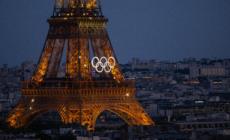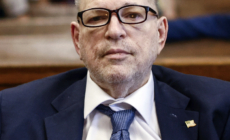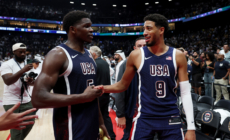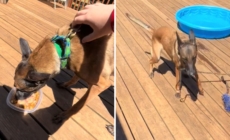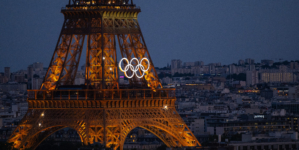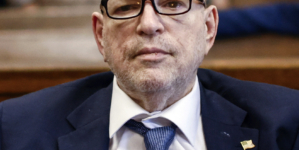-
Drinking Water Warning Issued for City in Kansas - 11 mins ago
-
Olympics News: Best Moments From the Opening Ceremony - 46 mins ago
-
Opening Ceremony Misses the Boat - 47 mins ago
-
Harvey Weinstein’s Medical Condition Takes Massive Turn - about 1 hour ago
-
Vivian Jenna Wilson, Elon Musk’s Transgender Daughter, Says He Was ‘Cruel’ and ‘Uncaring’ - 2 hours ago
-
How to Watch Men’s Basketball at the 2024 Paris Olympics: Streams, Schedule - 2 hours ago
-
Trump, Honing Attacks on Harris, Casts Her as a Far-Left Threat - 2 hours ago
-
Woman Explains Why She Decided To Have Rescue Dog Euthanized Over Behavior - 3 hours ago
-
Justice Dept. Defends TikTok Law That Forces App’s Sale or Ban - 3 hours ago
-
Archaeologists Find Ancient Egyptian Artworks Hidden Below Nile Waters - 3 hours ago
The Instagram Account That Shattered a California High School
As A. sat in the conference room, going through the images, she had trouble taking in what she saw. Then she saw a familiar photo. It had been lifted from her own Instagram account — her favorite picture from a trip to Lake Tahoe with her best friend. It had been paired with a photo of a gorilla. “I just got this stomach feeling of like, Wow, basically anything I do is not going to be good enough for these people,” A. told me. “I can’t even take a picture of myself in the snow, looking how I look, and post it on Instagram.”
That night, Charles, sobbing, called his sister, who was away at college. She wasn’t that alarmed at first, because he had called her in tears plenty of times, usually after getting into a fight with their mother, who had divorced their father a few years earlier. Compared with his sister, who had been both an academic and an athletic superstar in high school, Charles was kind of a slacker — smart enough to take advanced classes like A.P. computer science and A.P. physics but not motivated enough to get better than B’s and C’s. He had a close group of male friends that he had hung out with since middle school or even earlier, most of them white or Asian, and he also was tight with a couple of groups of Black and Asian girls. With the girls he tended to let his guard down more, allowing them to glimpse the depression that had dogged him since the collapse of his parents’ marriage. His stepfather, who is white, would send him emails brimming with spiritual advice. “Depression is one bad habit you cannot afford,” he wrote in one. “You may have every reason to be depressed, but accepting those reasons will only deepen your depression. Do not give in to the dark side. … Choose not to be depressed!”
This time, however, Charles wasn’t calling to complain about the usual family conflicts, which were often about his mother’s frustration with his passivity, his lack of drive, the amount of time he spent playing video games. “It’s really bad,” Charles told his sister. “I did something really bad.”
It took him a long time to tell her what. “We’re going to figure this out,” she assured him when he finally choked out a description of the Instagram account. She suggested he start by taking responsibility. He remembers writing his apology with her on the phone, the two of them editing it together. He posted it on Instagram that night:
I completely betrayed people who considered me a friend and I cannot even begin to explain how disgusting I feel. All things that were portrayed on the account do not actually portray my true feelings about people of color. I want to be someone with integrity, someone who cares about all people and someone who people can trust. I have not lived up to that at all. There’s no way for me to rationalize why I did what I did. It was all just my stupid judgment of what would entertain my friends. I cannot express enough that no one but me deserves any hostility or consequences. I don’t expect forgiveness because my actions are unforgivable.
Then, exhausted from crying, he fell asleep.
The account had started at a chain restaurant called the Melt that was known for its grilled-cheese sandwiches. Charles was sitting in a booth with three friends, two of them the children of first-generation immigrants from China and the third a white boy who carried the cachet of also being friends with the high school’s popular kids. It was a winter weekend day sometime late in 2016 or maybe early in 2017, and the four boys, as they later explained in interviews and court documents, were doing what they always did when they were together: trying to make one another laugh. As they waited for their food, Charles scrolled through pictures on his phone — memes he had made, photos he had saved for future memes. His model was the stuff he saw online, in YouTube videos and subreddits, material that seemed funny precisely because it was offensive. Charles didn’t think too deeply about the morality of that kind of thing. What mattered was that these memes made his friends laugh.
Humor was the glue of their friend group. They were the class clowns and the envelope pushers. The ones far more focused on cracking one another up in class than on whatever they were supposed to be learning. Put-downs, roasts and pranks were how they jockeyed for status.
Source link



